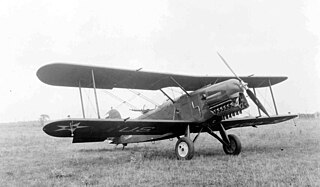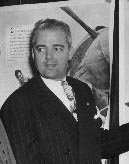Related Research Articles
The Curtiss-Wright Corporation is a manufacturer and services provider headquartered in Davidson, North Carolina, with factories and operations in and outside the United States. Created in 1929 from the consolidation of Curtiss, Wright, and various supplier companies, the company was immediately the country's largest aviation firm and built more than 142,000 aircraft engines for the U.S. military during World War II.

The Curtiss Falcon was a family of military biplane aircraft built by the American aircraft manufacturer Curtiss Aeroplane and Motor Company during the 1920s. Most saw service as part of the United States Army Air Corps as observation aircraft with the designations O-1 and O-11, or as the attack aircraft designated the A-3 Falcon.

The Douglas Y1B-7 was a 1930s American bomber aircraft. It was the first US monoplane given the B- 'bomber' designation. The monoplane was more practical and less expensive than the biplane, and the United States Army Air Corps chose to experiment with monoplanes for this reason. At the time the XB-7 was ordered, it was being tested by Douglas Aircraft as an observational plane.

The Curtiss SOC Seagull was an American single-engined scout observation seaplane, designed by Alexander Solla of the Curtiss-Wright Corporation for the United States Navy. The aircraft served on battleships and cruisers in a seaplane configuration, being launched by catapult and recovered from a sea landing. The wings folded back against the fuselage for storage aboard ship. When based ashore or on carriers the single float was replaced by fixed wheeled landing gear.

The Douglas XA-2 was an American prototype attack aircraft converted from a Douglas O-2 observation aircraft in the spring of 1926 by Douglas Aircraft. Only one prototype aircraft was built and the type was not ordered into production.

The Curtiss O-52 Owl is an observation aircraft used by the United States Army Air Corps before and during World War II. They were used for anti-submarine searches in Americas and by lend-lease also used on the Eastern Front in Europe by the Soviets.

The Douglas O-31 was the Douglas Aircraft Company's first monoplane observation straight-wing aircraft used by the United States Army Air Corps.

The Douglas O-43 was a monoplane observation aircraft used by the United States Army Air Corps.

The Douglas O-2 was a 1920s American observation aircraft built by the Douglas Aircraft Company, powered by the Liberty engine of WW1 fame, with some later variants using other engines. It was developed into several versions, with 879 being produced in total. It was used in combat by the Chinese Air Force in the 1930s and also was the basis for a successful mailplane version.

The Curtiss BF2C Goshawk was a United States 1930s naval biplane aircraft that saw limited success and was part of a long line of Hawk Series airplanes made by the Curtiss Aeroplane and Motor Company for the American military, and for export as the Model 68 Hawk III.

The Thomas-Morse O-19 was an American observation biplane built by the Thomas-Morse Aircraft Company for the United States Army Air Corps.

The 113th Air Support Operations Squadron is a unit of the Indiana Air National Guard 181st Intelligence Wing located at Terre Haute Air National Guard Base, Indiana.

The 2nd Air Refueling Squadron, sometimes written as 2d Air Refueling Squadron, is a unit of the United States Air Force. It is part of the 305th Air Mobility Wing at McGuire Air Force Base, part of Joint Base McGuire-Dix-Lakehurst, New Jersey. The 2nd Air Refueling Squadron is the second-oldest squadron in the Air Force, having over 100 years of service to the nation. It was deployed to the Philippines after World War I, during the 1941-1942 Battle of the Philippines, it was wiped out, with the Japanese forcing some of the personnel to endure the Bataan Death March. It was re-formed as an air refueling squadron by Strategic Air Command in 1949. Today, it operates the KC-46 Pegasus aircraft, conducting aerial refueling missions.

The Curtiss O-40 Raven was an American observation aircraft of the 1930s which was built and used in small numbers. A single example of the YO-40, a single-engined Sesquiplane with a retractable undercarriage was built, followed by four examples of a modified monoplane version, the O-40B, which remained in use until 1939.

Herbert O. Fisher was an American test pilot and an aviation executive, overseeing aviation projects at the Port Authority of New York and New Jersey. He worked for the Curtiss-Wright Corporation. Fisher flew as a pilot for over 50 years, racking up 19,351 accident and violation free hours.
The P-47 Thunderbolt is a World War II fighter aircraft built by Republic Aviation from 1941 to 1945.
The Martin XO-4 was a proposed observation aircraft designed by the Glenn L. Martin Company. It was designed to compete with the Curtiss XO-1, Douglas XO-2, and Dayton-Wright XO-3, and was to be powered by a Wright T-3 Tornado or a Liberty V-1650. Although it failed to receive a contract from the United States Navy, a single prototype was ordered by the United States Army Air Service, but this contract was canceled before the prototype could be built.
References
- ↑ "O – Observation Aircraft". 2007-03-16. Archived from the original on 2007-03-16. Retrieved 2020-06-15.
- ↑ "Curtiss L-Z". www.aerofiles.com. Retrieved 2020-06-15.